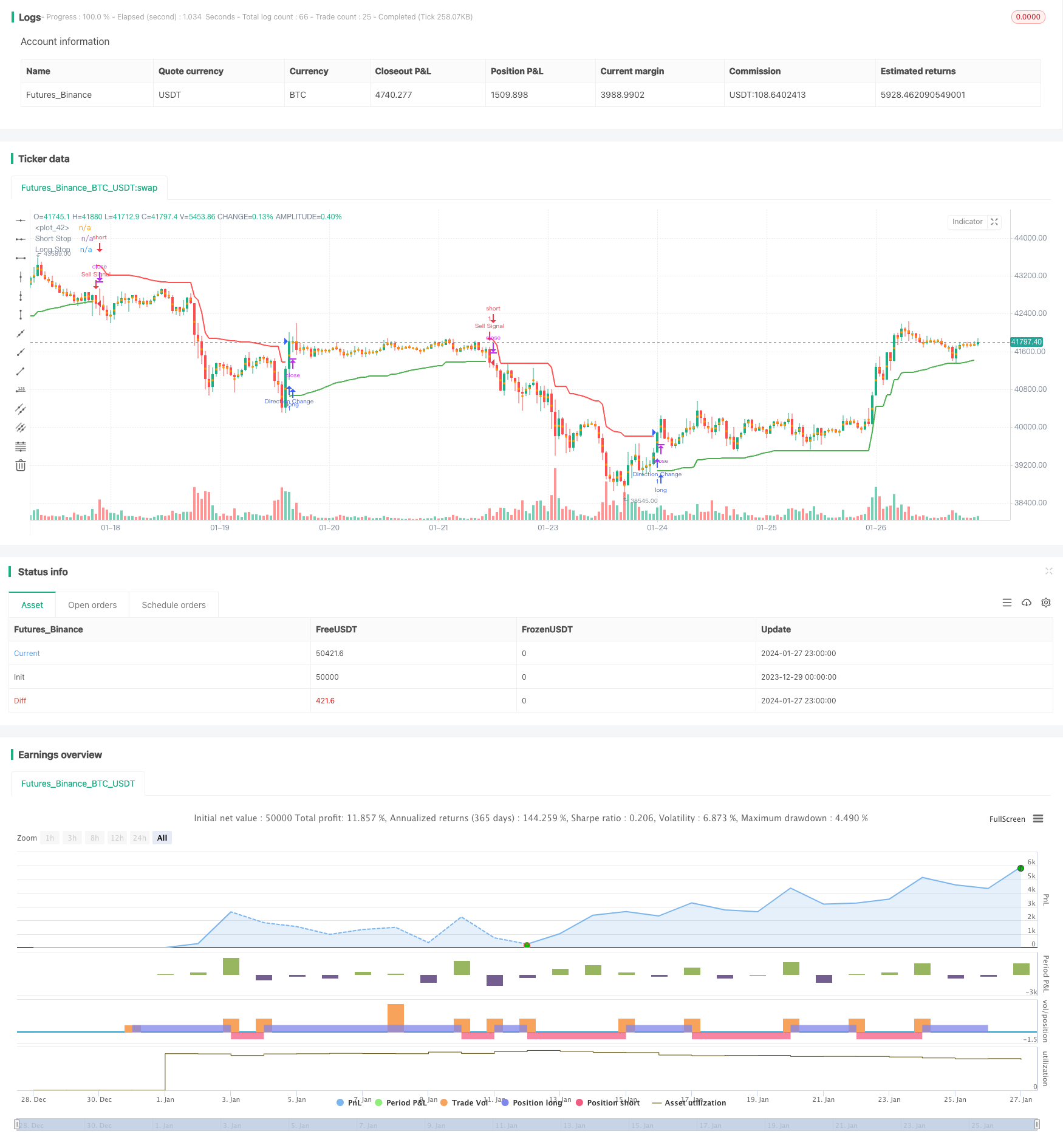
概述
该策略采用动态 trailing stop 的思路,根据ATR和价格极值来计算长短仓止损线。结合Chandelier Exit的思想,根据止损线朝向判断长短仓方向。当止损线向上突破时判断为看涨,做多;当止损线向下突破时判断为看跌,做空。
该策略同时具有止损和入场信号判断的双重功能。
策略原理
该策略主要由以下几部分组成:
基于ATR计算长短仓止损线
基于用户设定的ATR周期length和倍数mult,实时计算ATR。然后根据ATR与价格极值计算长短仓止损线:
longStop = 最高价 - ATR shortStop = 最低价 + ATR利用突破判断交易方向
比较前一根K线的止损线和当前K线的止损线。如果当前K线的止损线发生突破,则发出交易信号:
长仓止损线上方突破,做多 短仓止损线下方突破,做空根据风险回报比设置止损和止盈
根据用户设定的风险回报比riskRewardRatio,从ATR计算出止损距离和止盈距离。 并在开仓时设置止损单和止盈单。
优势分析
该策略具有以下优势:
动态追踪止损,及时止损
该策略采用动态追踪止损线,能够及时止损和控制下跌风险。
同时具备止损和入场判断功能
该策略止损线同时作为入场判断条件,简化了策略逻辑。
可设定风险回报比
根据设定的风险回报比,适当追求更大利润。
容易理解、扩展
该策略结构简单,容易理解和优化扩展。
风险分析
该策略也存在一些风险:
双边风险
该策略是双边交易策略,同时承担做多和做空的风险。
ATR参数依赖
ATR参数设置会直接影响止损线和交易频率,设置不当可能导致止损过于宽松或交易频率过高。
趋势市场适应性
该策略更适合盘整均线后突破的情况,不适合趋势性太强的场景。
针对以上风险,可以从以下方面进行优化:
结合趋势指标
结合MA等趋势指标,判断市场趋势,避免逆势交易。
优化参数组合
优化ATR参数以及风险回报比参数,使止损和止盈更合理。
增加过滤条件
增加交易量或波动性指标的过滤条件,确保交易质量。
优化方向
该策略还有进一步优化的空间:
结合机器学习
利用机器学习模型预测价格趋势判断,提高入场准确性。
利用 Options构建无风险组合
利用期权对冲品种的价格波动率,构建无风险套利组合。
多品种跨市场套利
在不同市场、不同品种之间进行统计套利,获得稳定的Alpha。
算法交易
通过算法交易引擎进行高效的策略回测和实盘交易。
总结
本文深入分析了一种基于动态追踪止损的量化交易策略。该策略同时具有止损管理和交易信号判断功能,能够有效控制风险。我们还分析了策略的优势、可能存在的风险以及后续的优化思路。该策略是一个非常实用的交易策略,值得进一步研究与应用。
/*backtest
start: 2023-12-29 00:00:00
end: 2024-01-28 00:00:00
period: 1h
basePeriod: 15m
exchanges: [{"eid":"Futures_Binance","currency":"BTC_USDT"}]
*/
//@version=5
strategy("Chandelier Exit with 1-to-1 Risk-Reward", shorttitle='CE', overlay=true)
// Chandelier Exit Logic
length = input.int(title='ATR Period', defval=22)
mult = input.float(title='ATR Multiplier', step=0.1, defval=3.0)
useClose = input.bool(title='Use Close Price for Extremums', defval=true)
atr = mult * ta.atr(length)
longStop = (useClose ? ta.highest(close, length) : ta.highest(length)) - atr
longStopPrev = nz(longStop[1], longStop)
longStop := close[1] > longStopPrev ? math.max(longStop, longStopPrev) : longStop
shortStop = (useClose ? ta.lowest(close, length) : ta.lowest(length)) + atr
shortStopPrev = nz(shortStop[1], shortStop)
shortStop := close[1] < shortStopPrev ? math.min(shortStop, shortStopPrev) : shortStop
var int dir = 1
dir := close > shortStopPrev ? 1 : close < longStopPrev ? -1 : dir
// Risk-Reward Ratio
riskRewardRatio = input.int(1, title="Risk-Reward Ratio", minval=1, maxval=10, step=1)
// Calculate Take Profit and Stop Loss Levels
takeProfitLevel = atr * riskRewardRatio
stopLossLevel = atr
// Entry Conditions
longCondition = dir == 1 and dir[1] == -1
shortCondition = dir == -1 and dir[1] == 1
// Entry Signals
if (longCondition)
strategy.entry("Long", strategy.long, stop=close - stopLossLevel, limit=close + takeProfitLevel)
if (shortCondition)
strategy.entry("Short", strategy.short, stop=close + stopLossLevel, limit=close - takeProfitLevel)
longStopPlot = plot(dir == 1 ? longStop : na, title='Long Stop', style=plot.style_linebr, linewidth=2, color=color.green)
shortStopPlot = plot(dir == 1 ? na : shortStop, title='Short Stop', style=plot.style_linebr, linewidth=2, color=color.red)
midPricePlot = plot(ohlc4, title='', style=plot.style_circles, linewidth=0, display=display.none, editable=false)
fill(midPricePlot, longStopPlot, color=color.new(color.green, 90), title='Long State Filling')
fill(midPricePlot, shortStopPlot, color=color.new(color.red, 90), title='Short State Filling')
// Alerts
if (dir != dir[1])
strategy.entry("Direction Change", strategy.long, comment="Chandelier Exit has changed direction!")
if (longCondition)
strategy.entry("Buy Signal", strategy.long, comment="Chandelier Exit Buy!")
if (shortCondition)
strategy.entry("Sell Signal", strategy.short, comment="Chandelier Exit Sell!")